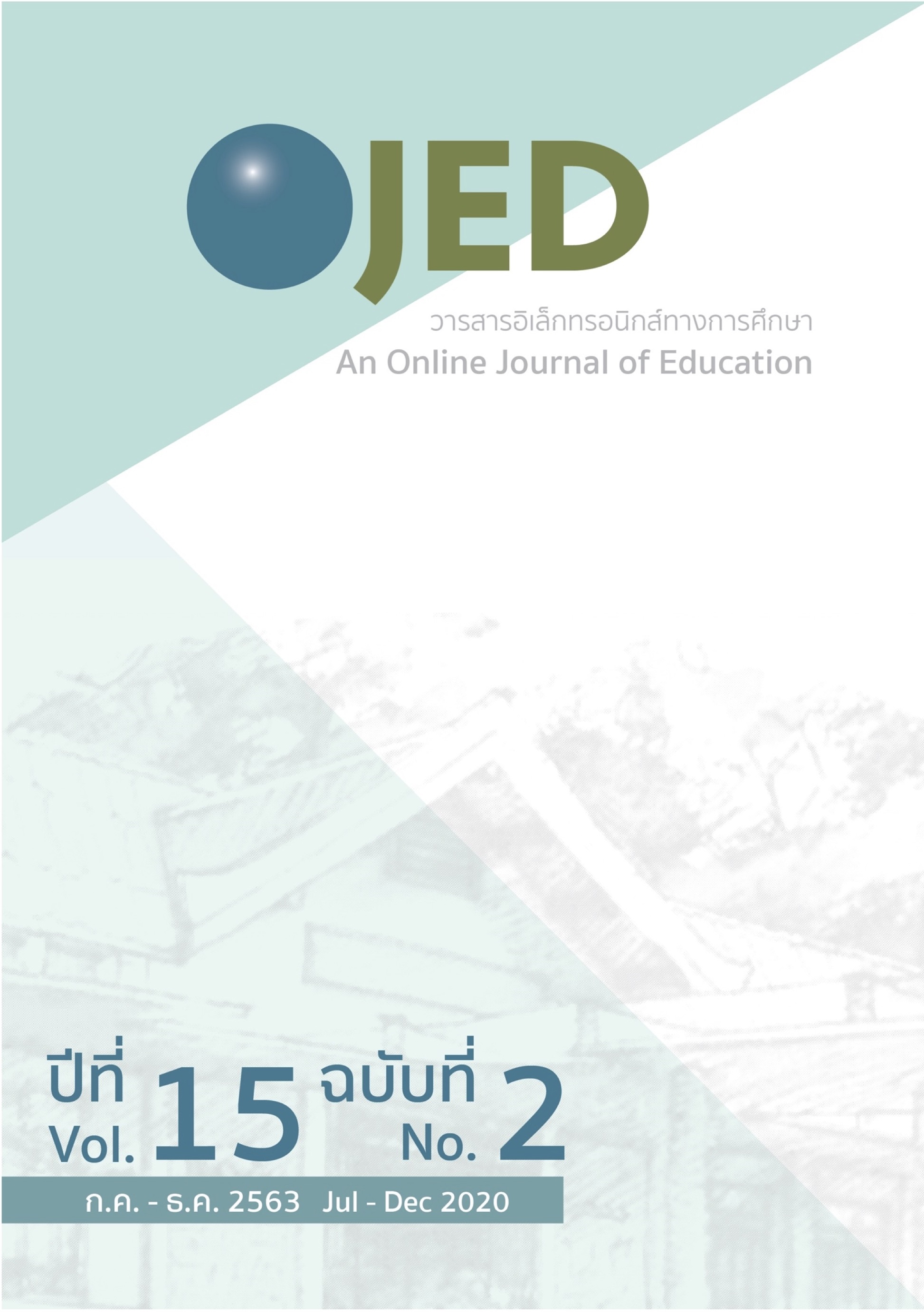The Comparison of Attitudes towards Online Learning via Video and Live Broadcasting of Fourth year Medical Students at Medical Education Center, Surat Thani Hospital
DOI:
https://doi.org/10.14456/ojed.2020.42Keywords:
attitude, online learning, medical studentsAbstract
This qualitative research aimed to study attitudes towards online learning via video and live broadcasting of fourth year medical students at Medical Education Center, Surat Thani Hospital and to study the comparison of attitude towards online learning via video and live broadcasting. The data were collected using an administered questionnaire. The sample of this paper was 30 participants selected by purposive sampling. Data were analyzed using descriptive statistics. The results of the research found that there are differences in attitudes towards online learning via video and live broadcasting in various following issues: 1) For teachers, online learning via video allows them to cover content and speak without a need to hurry but there is less interaction between the teacher and students compared to live broadcasting. 2) Content such as online learning via video is useful to review content; however, it is not suitable for content that requires discussion or practice and is different from live broadcasting. 3) For students, online learning via video allows them to study at their own convenience and therefore differs from live broadcasting, which has to be attended at a specified time. 4) Equipment such as online learning via video often suffers from blackouts and internet connection problems. It can be changed so the video can be watched later. Moreover, internet connection problems during a live broadcast delay attending classes. 5) For the environment, online learning via video is more convenient than live broadcasting in terms of location, posture, and dress code. The adoption of online learning should be based on its objectives and benefits and take into account the readiness of the teacher, content, students, equipment and the environment.
References
จเรวัฒน์ เทวรัตน์. (2557). การพัฒนาเครือข่ายสังคมออนไลน์ของศูนย์วิทยพัฒนามหาวิทยาลัยสุโขทัยธรรมาธิราช นครศรีธรรมราช สำหรับนักศึกษา. มหาวิทยาลัยสุโขทัยธรรมาธิราช.
บุญทิพย์ สิริธรังศรี. (2563). การจัดการเรียนการสอนออนไลน์สู่กรอบมาตรฐานวิชาชีพการสอนและสนับสนุนการเรียนรู้ระดับอุดมศึกษา. วารสารวิชาการราชวิทยาลัยจุฬาภรณ์, 2(3), 1-17. https://he02.tci-thaijo.org/index.php/jcra/article/view/241595
ปัทมา นพรัตน์. (2548). E-learning ทางเลือกใหม่ของการศึกษา. วารสารกรมวิทยาศาสตร์บริการ, 53(167), 15-16. http://lib3.dss.go.th/fulltext/dss_j/2548_53_167.pdf
พิศิษฐ ตัณฑวณิช และ พนา จินดาศรี. (2561). ความหมายที่แท้จริงของค่า IOC. วารสารการวัดผลการศึกษามหาวิทยาลัยมหาสารคาม, 24(2), 3-12. https://so02.tci-thaijo.org/index.php/jemmsu/article/view/174521/124950.
พัชฎา บุตรยะถาวร. (2558). ผลการสอนของวิธีการสอนแบบห้องเรียนกลับด้านด้วยการเรียนออนไลน์กับวิธีการสอนแบบสืบเสาะ เรื่อง ระบบไหลเวียนเลือด [วิทยานิพนธ์ปริญญาวิทยาศาสตรมหาบัณฑิต]. ระบบฐานข้อมูลวิทยานิพนธ์และงานวิจัย มมส. http://khoon.msu.ac.th/fulltextman/full4/patcha9899/titlepage.pdf
แพรภัทร ยอดแก้ว. (2551). ความสัมพันธ์ระหว่างพฤติกรรมทางจริยธรรมกับภาวะผู้นำการเปลี่ยนแปลงของนักศึกษามหาวิทยาลัยสยาม. มหาวิทยาลัยสยาม. http://www.research-system.siam.edu/2013-12-20-03-57-52/151-2013-12-20-05-58-64
ภูษิต วงศ์หล่อสายชล. (2555). การวิจัยและพัฒนาคู่มือกลยุทธ์การส่งเสริมกลยุทธ์การเรียนแบบกำกับตนเองในบริบทการเรียนออนไลน์ของนักศึกษามหาวิทยาลัยด้วยการออกแบบการเก็บรวบรวมข้อมูลผ่านออนไลน์ [วิทยานิพนธ์ปริญญาครุศาสตรดุษฎีบัณฑิต]. Chulalongkorn University Intellectual Repository (CUIR). http://cuir.car.chula.ac.th/handle/123456789/37555
รพีพรรณ รัตนวงศ์นรา มอร์ด. (2563, 10 กรกฎาคม). 7 วิธีเว้นระยะห่างทางสังคม Social distancing. คณะแพทยศาสตร์โรงพยาบาลรามาธิบดี มหาวิทยาลัยมหิดล. https://med.mahidol.ac.th/sites/default/files/public/img/infographics/infographics172-190363_0.pdf
วรรษมน จันทรเบญจกุล. (2563, 10 กรกฎาคม). การป้องกันการติดเชื้อไวรัสโคโรนา2019. จุฬาลงกรณ์มหาวิทยาลัย. https://www.chula.ac.th/wp-content/uploads/2020/02/การป้องกันตนเองจาก-COVID-credit-ศูนย์โรคอุบัติใหม.pdf
วรัท พฤกษากุลนันท์. (2550, 10 กรกฎาคม). การเรียนการสอนผ่านเว็บ (Web-based instruction). ครูบ้านนอก. http://www.kroobannok.com/133.
อรุชา ตรีศิริโชติ, สุภิญญา พงษ์สังข์, พัชรินทร์ แสงจารึก, ดีพร้อม ศิริเขต, อรุณชัย แสงพาณิชย์, วิชิต วิริยะโรจน์, และ ชัยพฤกษ์ กุสุมาพรรณโญ. (2562). เจตคติของนิสิตแพทย์ต่อการใช้กลยุทธ์ห้องเรียนกลับทางในการเรียนรู้โรคผิวหนังในเด็ก. วารสารการแพทย์และวิทยาศาสตร์สุขภาพ, 26(1), 56-64. https://he01.tci-thaijo.org/index.php/jmhs/article/view/185709/130541
อัมพิกา คณานุรักษ์, ทวีวัฒนา วัฒนกุลเจริญ, และ วาสนา ทวีกุลทรัพย์. (2560). ระบบการเรียนการสอนผ่านสื่อสังคมออนไลน์ วิชาคอมพิวเตอร์เพื่องานอาชีพสำหรับนักศึกษาระดับประกาศนียบัตรวิชาชีพ วิทยาลัยการอาชีพปัตตานี. Veridian E-Journal, 10(1), 2173-2192. https://he02.tci-thaijo.org/index.php/Veridian-E-Journal/article/view/74559
Worldometers. (2020, July 10). COVID-19 Coronavirus pandemic. https://www.worldometers.info/coronavirus/
Formoso, D. B. (2017). Readiness of tertiary level students of Holy Angel University to enroll in online learning. Liberal Arts Review, 12(23), 1-11. https://so04.tci-thaijo.org/index.php/larhcu/article/view/146829
Downloads
Published
How to Cite
Issue
Section
License
Copyright (c) 2020 An Online Journal of Education

This work is licensed under a Creative Commons Attribution-NonCommercial-NoDerivatives 4.0 International License.




